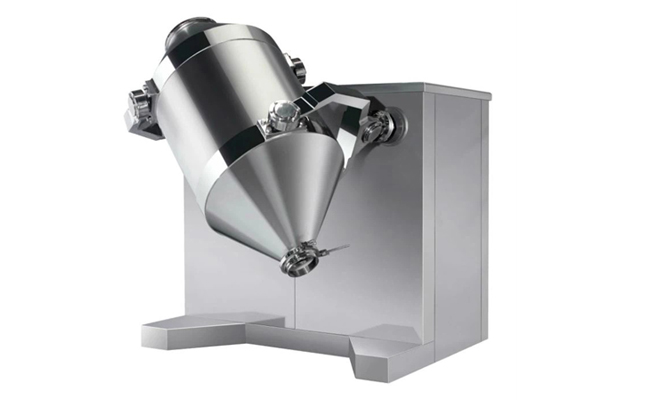CV-2535 Vertical Small Band Saw Machine for Metal
Cutting Capacity :
Detailed Technical Analysis of Dry Powder Mixer
A dry powder mixer is a specialized mechanical device used for blending dry powders or granular materials, widely applied in industries such as chemicals, construction materials, food, pharmaceuticals, pesticides, and feed. Its core function is to achieve uniform mixing of different powder components through mechanical agitation, convection, and shear forces, ensuring stable product quality.

1. Main Structure of a Dry Powder Mixer
A dry powder mixer typically consists of the following key components:
(1) Mixing Container (Mixing Drum)
Material: Stainless steel (304/316L), carbon steel (with anti-corrosion lining), wear-resistant alloys, etc., selected based on material characteristics.
Shape: Common shapes include U-type, conical, cylindrical, and double-cone, with different shapes affecting mixing uniformity and discharge efficiency.
(2) Mixing Mechanism
Helical Blades: Suitable for free-flowing powders, offering fast mixing.
Ribbon Mixer (Single/Double Ribbon): Counter-rotating inner and outer ribbons enhance convective mixing and reduce dead zones.
Paddle Mixer: Suitable for clumpy or sticky materials, capable of breaking up agglomerates.
High-Speed Chopper (Optional): Used for fibrous or clumpy materials to aid dispersion.
(3) Drive System
Motor: Standard motor, explosion-proof motor (for flammable environments), or variable-frequency motor (speed-adjustable).
Gearbox: Cycloidal or gear reducers to control mixing speed (typically 10-60 rpm).
(4) Feeding and Discharge System
Feeding Methods: Manual loading, pneumatic conveying, or screw conveyor for automatic feeding.
Discharge Methods: Manual valve, pneumatic/electric butterfly valve, or screw discharge (to minimize residue).
(5) Auxiliary Systems (Optional)
Heating/Cooling Jacket: For temperature-controlled mixing (e.g., food or chemical reactions).
Liquid Spray System: For solid-liquid mixing (e.g., adding liquid binders).
Dust Collection System: Connects to bag filters or cyclone separators to prevent dust pollution.
PLC Control System: Automated operation with programmable mixing time, speed, and temperature.
2. Main Types of Dry Powder Mixers
(1) Horizontal Dry Powder Mixer
Structure: Horizontal U-shaped trough with internal ribbon or paddle agitators.
Features:
High mixing uniformity (≥98%).
Suitable for large-scale continuous production (capacity: 0.5–10 tons).
Ideal for free-flowing powders (e.g., putty powder, animal feed).
(2) Vertical Dry Powder Mixer
Structure: Vertical drum with a screw lifting agitator.
Features:
Compact footprint, suitable for small-scale production.
Longer mixing time but lower energy consumption.
Suitable for materials that are prone to sedimentation or slightly sticky (such as pharmaceutical powder)
(3) Double Cone Blender
Structure: Cone-shaped drum with dual helical agitators (rotation + revolution).
Features:
Three-dimensional mixing with no dead zones, achieving ultra-high uniformity (≥99%).
Ideal for high-precision mixing (e.g., pharmaceuticals, high-value chemicals).
Short mixing time (typically 5–15 minutes).
(4) V-Type Dry Powder Mixer
Structure: Two intersecting cylinders forming a V-shape, blending via tumbling motion.
Features:
Suitable for lightweight, free-flowing powders (e.g., food additives).
Fast mixing but limited capacity (typically 50–1000L).
(5) Plowshare Dry Powder Mixer
Structure: Horizontal drum with high-speed plow blades and choppers.
Features:
Designed for clumpy or fibrous materials (e.g., cellulose, pigments).
Combines mixing and dispersion to prevent agglomeration.
3. Key Parameters of Dry Powder Mixers
| Parameter | Description | Typical Range |
|---|---|---|
| Capacity | Batch mixing volume | 50L – 10m³ |
| Power | Motor power (kW) | 1.5 – 55 kW |
| Mixing Uniformity | Consistency of blended components | ≥95% – 99.9% |
| Mixing Time | Time per batch | 5 – 30 minutes |
| Rotation Speed | Agitator speed | 10 – 60 rpm |
| Material | Contact parts material | SS304, carbon steel, PP |
4. Applications of Dry Powder Mixers
(1) Construction Industry
Putty Powder: Mixing cement, gypsum, cellulose, etc.
Dry Mortar: Tile adhesive, thermal insulation mortar, self-leveling compounds.
Refractories: Blending alumina, silica powder, etc.
(2) Chemical Industry
Dyes/Pigments: Ensuring color uniformity.
Fertilizers: Mixing NPK nutrients.
Plastic Additives: Fillers, flame retardants.
(3) Food Industry
Seasoning Powders: Chili powder, curry powder, instant soup mixes.
Milk/Protein Powders: Uniform blending of nutritional fortifiers.
(4) Pharmaceuticals/Pesticides
Drug Powder Mixing: Tablet ingredients, herbal powders.
Pesticide Formulations: Powdered or wettable powders (WP).
(5) Feed Industry
Premixes: Uniform distribution of vitamins, minerals, amino acids.
5. Selection Criteria for Dry Powder Mixers
Material Properties
Particle size (mesh), density differences, flowability, stickiness, clumping tendency.
Corrosive materials require stainless steel or coated surfaces.
Mixing Uniformity Requirements
High-precision mixing (e.g., pharmaceuticals) demands double cone or V-type mixers.
Standard mixing (e.g., construction) can use horizontal ribbon mixers.
Production Capacity
Lab-scale: 5–100L.
Industrial-scale: 0.5–10 tons/batch.
Special Requirements
Explosion-proofing (for flammable dust).
Sterile environments (pharmaceuticals, food).
Heating/cooling functions (reactive mixing).
6. Maintenance & Common Issues
(1) Routine Maintenance
Regularly inspect bearings and gearbox lubrication.
Clean agitator blades and drum residues.
Check seals to prevent dust leakage.
(2) Common Failures & Solutions
| Issue | Possible Cause | Solution |
|---|---|---|
| Poor Mixing | Low speed, large density differences | Adjust speed, extend mixing time |
| Motor Overheating | Overloading, unstable voltage | Check load, ensure stable power supply |
| Powder Leakage | Worn seals, unsealed ports | Replace seals, inspect valves |
| Abnormal Noise | Damaged bearings, blade collisions | Replace bearings, realign agitator |
7. Future Trends
Smart Mixing: IoT-enabled remote monitoring and auto-adjustment.
Energy Efficiency: High-efficiency motors and optimized designs.
Modularity: Quick-change components for diverse materials.
Nano-Mixing: For advanced pharmaceuticals and electronics.
Conclusion
Dry powder mixers are essential in powder processing, with selection depending on material properties, mixing precision, capacity, and cost. Different industries have varying requirements for uniformity, hygiene, and safety. Future advancements will focus on automation and efficiency, driven by smart manufacturing.
Cutting Capacity :
Cutting Capacity :